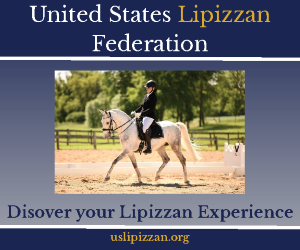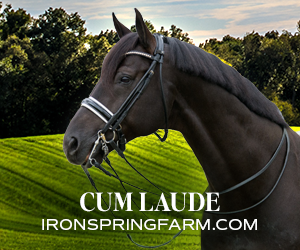Before he became the most famous horse in dressage history, “Blueberry” was a horse with too much “go” and his rider had trouble sitting the trot. Here’s how the legendary partnership started.
By Charlotte Dujardin
Reprinted from March 2018 USDF Connection magazine.
Excerpt adapted from The Girl on the Dancing Horse, available from Trafalgar Square Books (horseandriderbooks.com).

Blueberry’s story had begun on 5 July 2002 when he was born on Burgh Haamstede, an island in the Netherlands. His breeders, Maartje and Joop Hanse, decided to call him Vainqueurfleur, which was a combination of his mother’s name, Maifleur, and vainquer, which is French for victor. Valegro’s sire was the black dressage stallion Negro, and it was from Negro that Valegro got his stockiness and short, strong legs.
Vainqueurfleur became Valegro when he was sold as a colt to Negro’s owner, Gertjan van Olst. Gertjan’s wife, Anne, was an international rider who sometimes trained with my mentor, British Olympian Carl Hester. While Carl was visiting Holland in 2005, Anne took him to see the KWPN stallion show and grading. One young horse particularly caught Carl’s eye, and that turned out to be Valegro—even then, as Carl says, he had “the head of a duchess and the bottom of a cook.” But although he obviously had massive power in his hindquarters, it seemed at the time that Valegro was never going to be big and special enough to keep as a stallion for breeding. He was gelded, and because he wasn’t expensive, Carl decided to buy him.
Valegro’s career had got off to a winning start with the four-year-old championship, and he’d also won the 2006 Badminton Young Dressage Horse of the Future title, but nobody knew what would happen next. He was small and squat, just over 16 hands, so for Carl—who is well over six feet—he was far from ideal. His canter was also so massive it hurt Carl’s back, which was already bad, while his other paces were pretty normal: to begin with, it was only in canter that Blueberry looked like such an amazing horse.

From the first moment I loved him, absolutely loved him. Valegro was fiery, he was sensitive, he was expressive, he was powerful—everything I’d always wanted in a horse, he was. It felt like he was the missing piece I hadn’t realized I’d been waiting for. You know when you get on a horse whether you like it or you don’t, but Blueberry gave me a feeling like I’d never experienced: There was such a strong connection straight away. Even his shape was part of it: When you sit on Blueberry you really feel like you’re part of him because he’s so solid and built like a barrel; your legs wrap right the way ’round.
You’ve got a good length of neck in front of you, but behind you you’ve got hind legs pounding like pistons, almost too much for the front end to cope with. The power was like nothing I’d ever felt in my life: When I asked for canter it was like we were going to take off. Some horses canter and just cover the ground, but with Blueberry you felt like you were actually leaving the floor, the moment of suspension was so big. The only thing I can compare it to is a roller coaster: It gave me that same thrill in the pit of my stomach, the buzz of going so fast it was almost like I was going to lose control.
Unusual Horse, Unusual Solutions

Even then, I could feel how much I could achieve with Valegro: This was my dance partner. But when I first started riding him, the real problem wasn’t so much his lack of size or his unruliness as his headshaking, and it was so serious that Carl was beginning to think he might not even have a career.
Nobody really knows what causes headshaking, or how to cure it. Carl had had tried all sorts of medicines, had all sorts of specialists out, and had even thought about having Blueberry operated on, but what it seemed to come down to was that he was so sensitive to everything. Nothing could touch Blueberry’s skin: Even metal buckles would sometimes give him a rash, so we’d have to make sure there was a cloth over them to protect him. In the summer he’d get hay fever and his eyes would start running; even extra-strong mints would make his nose run. He’d eat the mint, which he loved, but then he’d get stressed because his nose would run and tickle his face, and that would set his headshaking off. Flies had the same effect: If one even slightly touched his face or nose, he’d strike out with his leg or shake his head violently.
I was always trying to pick up on every little thing that might trigger it, because you’d be with him and he’d be trying to bang his head or rub his face with his legs or drag his nose up the walls. It was so bad that Carl had even tried radionics, which is a form of complementary therapy. Horse people sometimes call radionics “the black box” because you give a sample of your horse’s hair to a radionics practitioner, who takes it away and puts in a black, box-like machine. The idea is that they then use “radionic therapy” to perform a kind of energy healing—you never actually see them do it, and your horse doesn’t have to be present; you just pay your £20 a month and the problem is meant to get better.
Carl is not at all the sort of person who believes in that kind of thing, and many people think it’s a myth, but there did seem to be some change in Blueberry after we started him on it, so Carl decided to keep it going. With time, we found out that putting Blueberry in a double bridle helped too. Normally, you put a double bridle on a horse when they’re six, coming seven, because until then their teeth are changing; it’s also important that you can still get them listening and responding in just a snaffle. Blueberry was five and a half, but the curb chain definitely seemed to make a difference: It lies on an acupuncture pressure point, and although straightforward acupuncture hadn’t worked for Blueberry, with the curb chain on he did seem to be more relaxed. What’s more, it gave me more control over him, which in turn made him less nervous—Blueberry was the kind of horse who, if he didn’t feel as if his rider was in charge, would start to worry.
Early Training
It sounds funny, but the problem with Blueberry was that he tried so hard. Rather than waiting and listening to my aids, he was always trying to jump ahead, and then when he didn’t understand what you wanted him to do, he’d get tense: It was all go, go, go and no whoa, whoa, whoa. Tension would always make Blueberry’s headshaking worse, and the more I tried to figure him out, the more I realized that it was almost like a form of Tourette’s: His work ethic was incredible, but his brain was on overdrive. Sometimes all you wanted was to tell him to take a breath and just slow down.
There were two arenas at the yard where Carl was then based, an indoor and an outdoor. The indoor was smaller, so that’s where I rode Blueberry: With less space and four walls around him, it was easier to keep him under control.
As well as working to make him more relaxed, I was also trying to get him more supple. Tension would make him tight in his body, and while some horses get stiff in their mouths and necks, with Blueberry, it was his whole body that would go rigid. I concentrated on lots of easy, basic transitions and simple exercises—things that he could cope with and wouldn’t get him stressed—and the more relaxed he was, the better he got.
Because people have always seen Blueberry winning medals and breaking records, they find it hard to believe he wasn’t scoring tens across the board from the start. In young-horse classes he never scored that highly for his trot, though: He loved trot and canter extensions because he could just power off, but if you’d have seen his normal trot back then, there wasn’t a lot to it. His bouncy, spilling-over-with energy walk cost him marks, too. He was always so eager to be doing the next thing that the slightest touch of your leg would set him off, but then when you asked him to walk he didn’t know what to do with himself. Walk would always be Blueberry’s most expensive pace in terms of marks, because rather than being relaxed he’d be like a cat on hot bricks, bouncing up and down. He loved his job so much you could feel him thinking, “What should I do? I’m meant to be doing something! What is it?” Then you’d pick up your reins ready for the transition, and he’d be so keen to go he’d almost start to piaffe.
What I’ve learned from my experience competing in young-horse classes is that you don’t need big paces in a young Grand Prix horse, just three correct paces you can train. It’s not often that horses that are really big movers and scoring tens when they’re young go on to have long careers, simply because of all the wear and tear on their bodies. Good Grand Prix horses can also be quite tense when they’re young because they’re hot and want to be going forward, and that again can cause them to score less well in terms of submission.
Carl’s nickname for Blueberry was “The Professor” because he always said it was as though he’d read the dressage encyclopedia in his stable. He had trainability, but he was also naturally talented in that he had the ability to sit—which is essential for exercises like piaffe and pirouettes—and he could push when you asked for extensions. Most horses are better at one or the other, but Blueberry could do both without stressing himself out, although that doesn’t mean he found everything easy. You’d never have imagined that Valegro once found it hard to piaffe, but to start with he was so hot he couldn’t find the rhythm. Sometimes, when you’re training a young horse to piaffe, you lightly touch a whip on top of its bum to encourage it to find the bounce, but if you did that with Blueberry he’d be so sensitive and willing to go he’d just try to canter.
He didn’t quite know what to do with all the power he had, which also caused me problems trying to teach him flying changes and passage. Flying changes were easy for Blueberry; you just put your leg on and he was off like a rocket: It was like an explosion across the diagonal. The problem was he’d then get so excited and strong he’d start trying to do them everywhere. I had to keep doing a single change, patting him, then bringing him back to walk, over and over, so he learned that sometimes one was all I wanted. When he’d understood that, I could start putting them together, and his one-tempis ended up being like nothing I’d ever sat on in my entire life: You felt like he was climbing a hill and just getting higher and higher and higher with every stride.
With passage, his huge engine was again partly to blame. Blueberry’s hind legs were so good that all their power pushed him forward, and then he couldn’t quite cope with lifting his front end up as well. Because he was still a young horse he hadn’t yet developed the ability to balance himself, so every time I tried to create a bit of lift he just pulled more and more on my arms. Some horses are born with really nice mouths and are very light in your hands, and some have harder mouths and take a strong hold. Then there are horses like Blueberry, who have mouths like bricks, and by the time we’d finished my arms would be absolutely burning.
Rider Improvement

During this time, one of the things I was still struggling with was my sitting trot, which made me rely too much on my hands for balance. Carl would often tell me that showing had given me bad hands, which was true, and because he’s the kind of person who gives everyone a nickname I ended up as Edwina Scissorhands, or Eddie.
The key was getting stronger in my core, but even though I was swimming I still wasn’t fit enough; plus I was about two stones heavier than I should have been. Staying in shape is something I’d always had to work at quite hard, but at a previous barn the other working student and I would get through a loaf of bread with butter and jam for lunch every day. We’d wash it down with tea and biscuits, and owners would always bring cakes and treats when they came to the yard. I look back now and think it’s no wonder I was the size of the house, but I only realized it was a problem when I heard on the grapevine that Carl thought I could do with losing some weight.
Hearing that broke my heart, but he was right. I didn’t want to be anorexic, but if I wasn’t fit I couldn’t do my job, so I decided then that I was going to start going to the gym and get myself a personal trainer.
Unlike the first couple of PTs I tried, Jo Theyer understood that I still needed to be able to walk and sit down when she’d finished with me. She also came to study me ride and helped me identify that my right leg was weaker than my left. If you’re weak on one side it’s obvious that your horse will have problems on that side too, and it seems ridiculous that we spend heaps of money paying for our horses to have physio and massages but don’t think about the problems we might be causing as riders.
Charlotte Gets the Ride
Totilas, the world champion ridden by Edward Gal of the Netherlands, would be the horse Valegro was always compared to, and as it became obvious just how good Blueberry was, people started to wonder why I was riding him and not Carl. I knew people were already intrigued by me and wanted to know why Carl had taken me on, so I did feel like I had something to prove.
There was never a moment when I realized Carl wasn’t actually ever going to take Blueberry back. Nothing was ever said, and if we hadn’t been doing so well, I don’t think Carl would have hesitated to take the ride. But he himself was notching up the wins with Uthopia, and having been given so many opportunities by his mentor, Dr. Wilfried Bechtolsheimer, I knew Carl felt he wanted to give someone else a turn. What I didn’t know then was the other reason he finally decided to let me and Blueberry carry on: the idea he’d had that he and I on Uti and Blueberry might make the basis of a British team. Of course in all our wildest dreams neither of us could have foreseen how that was going to work out.















WONDERFUL STORY ABOUT AN INCREDIBLE HORSE!